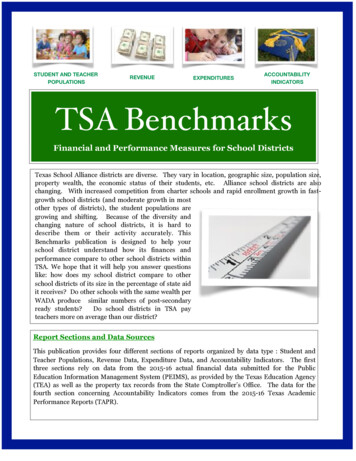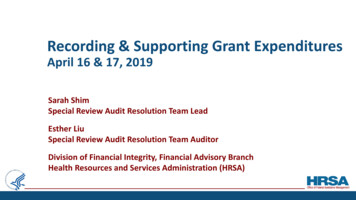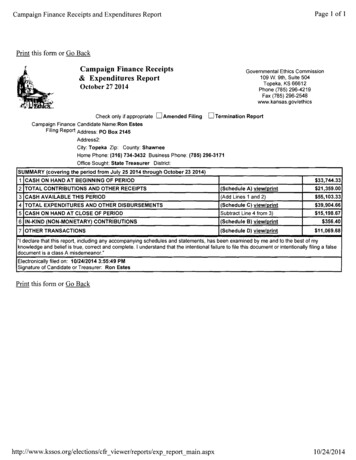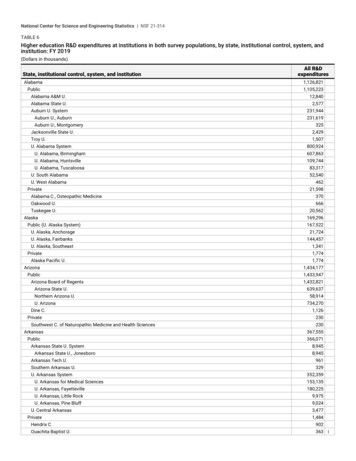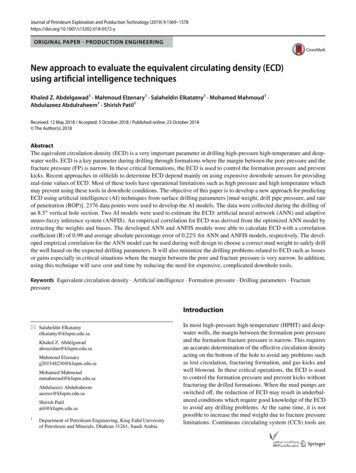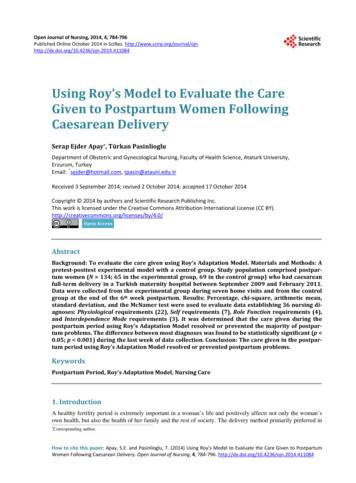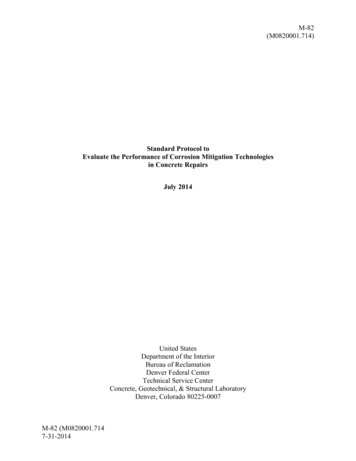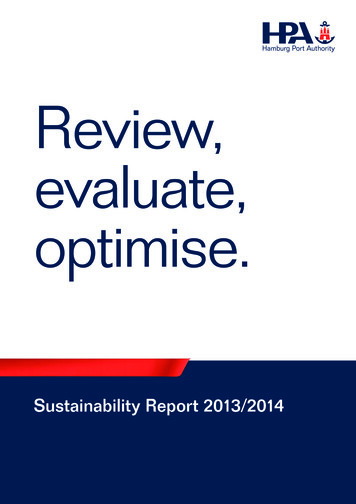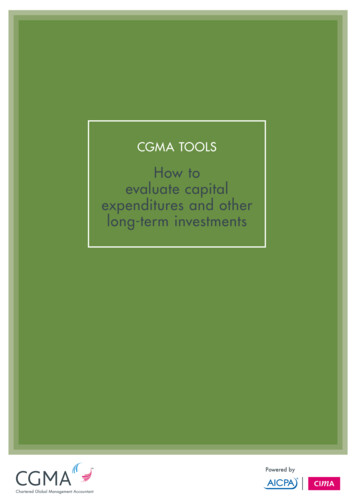
Transcription
CGMA TOOLsHow toevaluate capitalexpenditures and otherlong-term investmentsPowered by
CONTENTSTwo of the world’s most prestigious accounting bodies, AICPAand CIMA, have formed a joint-venture to establish the CharteredGlobal Management Accountant (CGMA) designation to elevatethe profession of management accounting. The designationrecognises the most talented and committed managementaccountants with the discipline and skill to drive strong on—IRR Versus Present Value6Financing8Hedging10Example111
IntroductionFinancial evaluations of capital expenditures and other long-terminvestments are very similar to evaluations of acquisitions. Bothrequire addressing unknowns, as well as specific management skills.Often, they represent options available to an organisation–buyversus build or develop. However, there are few key differences.Better-managed organisations view all long-termprogrammes (capital and noncapital) in a disciplinedenvironment. Therefore, we will explore some of theunique issues concerning budgeting and evaluating,financing, and managing a variety of activities.In addition to typical capital projects, expenses suchas research and development (R&D), informationtechnology, advertising, training, and even plannedbuilds in working capital can be viewed as long-termprogrammes. These all consume cash in anticipation offuture payouts. This tool will: Compare evaluating long-term projects with anacquisition. Discuss the role of budgeting. Examine the impact of capital projects on coststructure. Explore internal rate of return (IRR) as anevaluation tool and compare it to the present valueapproach. Introduce the basic concepts of financing andhedging.2How to Evaluate Capital
BudgetingA budget is a disciplined process to allocate resources and establishan organisation-wide plan to manage resources and activities. Itenables competition for resources (capital, people, time, and soon) to be constructive. If left unmanaged, competition for resourceswould result in destructive conflict or suboptimisation of limitedresources.Cash BudgetA first step for organisations with significant capital(cash) expenditures is to prepare both a standard profitand loss (P&L) budget and forecasts accompanied bya cash version. While balancing total cash receivablesand expenses over a budget period is obviouslyimportant, the actual timing is essential. Cash mustbe available when needed. Planned or unplannedincreases in working capital and operating costs reducefunds available for capital projects.A cash-based budget or plan will assist in identifyingthe imbalances of cash, allowing you to plan actionsin advance. It will also help establish a projectselection process, by setting a total capital cap on theorganisation. Although, an organisation may haveseveral “good” projects, often trying to do all of themwill increase costs (financing), strain management’sabilities or resources, and increase risk (financing,actual timing of project start-ups, and so on).Project ListAs part of the process, a list of proposed projectsneeds to be identified. These should have alreadypassed some evaluation (first-cut) and are now beingconsidered for funding. The goals of capital projectsinclude: Replacement.Expansion.Rationalisation – Productivity.Development – New products, process, or markets.Mandatory – Contractual or legal requirements.Grouping potential programmes into categories cansometimes help in the evaluation process. The next stepis to assure that the assumptions used in each case areconsistent. For example, the same inflation estimates,raw material cost escalations, and so on, have beenincorporated in each. Next, determine if the potentialprojects are independent of one another.Projects can be mutually exclusive; the funding of onestops the funding of another (for example, competingtechnologies). Also, projects can be dependent onone another. Be certain that you have identified allrequired expenditures for any proposal. These not onlyinclude the purchase and installation of equipment andconstruction of facilities, but more subtle modificationssuch as changes in working capital. Review box 1 on thefollowing page concerning analysing acquisitions from a“with” and “without” viewpoint. This will help you findless obvious changes during the evaluation. You do notwant to discover halfway into construction that yournew technology requires a major upgrade to the watersystem, and so on. Scaling-up a technology or projectoften comes with this risk. Remember, the projects arecompeting for the organisation’s limited resources.Although somewhat obvious, let us specifically discuss afew key issues concerning evaluating a group of projects.First, it is likely that the required return or hurdle ratewill vary by project type. Projects required by law or toassure safety don’t rely on returns. In these situationsyou are seeking the lowest cost, effective project. Theproject will get done even if it has negative returns. Ofthe remaining categories, hurdle rates for replacementswill be the lowest, because they are needed to maintainactivities and should have the least risk. Consequently,development projects will require the greatest returns(more unknowns).Other factors, such as location (political risk), sourcesof raw materials, and the concept of residual orabandonment value need to be considered and addressed.The capital committed to some investments may bereasonably flexible, while others are fixed. An investment3
Box 1“With” and “Without” ApproachIt is generally accepted that discounted cashflow calculations provide a more objectivebasis for evaluating investments. This approachaccounts for both the size and timing of forecastcash flows throughout the acquisitions life.The two techniques are present value andinternal rate of return (IRR). However, thegeneral approach between these methods issimilar.In forecasting the value of an acquisition, orany investment, the calculation strives to isolatethe effect of that action. Therefore, cash flowestimates should be done based on the resultsin a single-purpose facility (aircraft) is considerably morefixed than an office building in New York City. The twoproposals may have the same present value and IRR.However, if your business activity declines, the aircraft islikely a sunk cost (unrecoverable), while the office spacecan be sold or rented.For simplicity, the examples provided in this documentassume the independence of cash flows from one periodto another. However, for most investments the cash flowin one period depends, at least in part, on the cash flowin the previous periods. Poor early results increase thepotential for disappointing future returns. In addition,because of the reality of present value, the project’s overallreturns are likely to suffer.Project planning includes identifying, in advance, thosekey short-term activities that are directly related to thedesired long-term results. Failure in one of these selectactivities must trigger an immediate planned response.When reviewing investments it is important to determinethe degree of correlation of cash flows amongst agroup of projects. If the correlation is high, you may beintroducing a hidden level of risk. Just because you spreadexpenditures over a number of projects doesn’t assurediversification.Suppose you invested all your savings in the commonstocks of 5 companies, all of them in the same industry.Would you be achieving diversification? While you maybe reducing specific company risk, your investmentswould not be diversified.4How to Evaluate Capital“with” and “without” the acquisition. Thisprovides a more accurate picture of the valueof the cash flow, from the specific action, versusa “before” and “after” view. The “with” and“without” approach directly attempts to isolatethe impact of the acquisition from other factorsthat may influence the results. Increases ordecreases to cash flow that would have occurredwithout the acquisition are easier to see. Thiscan be helpful when identifying changes in bothscenarios for future capital spending, workingcapital, and so on. In addition, it provides amore accurate basis for measuring the value ofsynergies that result from the transaction. This isa critical point, because potential synergies playan important part in the eventual evaluation andnegotiations.The Kelly Criterion is a risk management strategywhich has been used to allocate investment funds. Thisapproach has gained some recognition as part of a processfor reviewing or selecting capital projects. The techniquewas developed by John Kelly in the 1950s at Bell Labs.However, it did not become popular until Edward Thorpwrote his book “Beat the Dealer,” in 1962.The goal is to maximise the long-term growth rate ofinvestments. It can be used as part of a dynamic approachfor capital allocation. The Kelly Criterion establishesboundaries for investing as results become known andavoids over-betting on an outcome. The basic thrust isto avoid “gambler’s ruin,” where you lose everything byover-betting. It is the opposite of the “double down” or“all-in” approaches, which attempt to regain losses byrisking increasingly larger sums.In a trading or investing situation, you would determinethe percentage of your total funds to be risked on eachalternative. Following the outcome of the investment,the earnings or losses would be added or subtracted toor from the total funds, and the same percentage riskedon the next trade, thus maintaining a disciplined anddiversified portfolio.While there are unique reasons for projects to beapproved, establishing a disciplined framework can behelpful when allocating overall resources. Dividing capitalexpenditures by project type (including technologies used,and so on) is a necessary first step. Employing guidelinesbased on this approach can be valuable not only in
initially allocating funds, but also as information is gainedduring development or implementation.Bill Gross, the famed bond investor and head of PIMCOis a disciple of this approach. Despite the fund’s size,it reportedly does not have more than 2% of its totalholdings invested in any one credit.AlternativesThe budgeting process is an excellent time to lookfor alternatives to capital projects. Whether ornot the availability of funds is a current problem,renting facilities or outsourcing activities needs tobe considered. As a result of the escalating cost fordeveloping new drugs, Eli Lilly helped to start alab in Shanghai during 2003. This has significantlyreduced their development costs. Companies routinelyoutsource both staff and production needs. View alllong-term commitments as you would capital projects.At times, conditions that are intrinsic to an industryare better addressed by not owing the capacity. Ask atleast the following questions: How accurately have we historically forecast demand?Is demand seasonal?Is demand cyclical?Is the work flow lumpy (projects or continuous)?Are noncapital alternatives available?By introducing this brief review you may find botha better solution to your operating needs, as well asadditional funds for other worthy projects.5
Valuation—IRR Versus Present ValueAccording to the IRR approach, an investment should beaccepted if the internal rate of return is greater than the cost ofcapital. When selecting among several projects, the IRR wouldbe calculated for each and the projects ranked by their ratesof return. The IRR is the discount rate which equates the presentvalue of cash flows to zero.The typical criterion for accepting a proposedprogramme is to compare the IRR to a preset hurdlerate. If IRR is equal to or greater than the hurdle rate,the project is normally accepted.that for an organisation’s financial results, an acceptable(lower) return on a large project may be better than ahigher return on a very small one.In addition, IRR incorporates a reinvestment rate forintermediate cash flows, equal to the internal rate ofreturn. The present value approach uses a rate equal tothe required rate of return used as the discount factor.Be aware of the above built-in assumptions and selectthe tool that best fits your situation. The net presentvalue approach is usually viewed as the more reliable.IRR solves for the discount rate that equates thepresent value of the cash inflows with the present valueof the outflows. This is then compared to the requiredhurdle or cut-off rate. The present value method (seebox 2 on the following page) solves for the net presentvalue of the forecast cash flows given a required rate ofreturn. Therefore, any investment with a net presentvalue greater than zero, in theory, is acceptable. Whilethese techniques approach the same question from adifferent view, they tend to lead to the same conclusion(acceptance or rejection).The following illustration demonstrates the relationshipbetween the present value and IRR approaches.An opportunity requires an up-front investment of 18,000 and is forecast to generate annual cash flows of 5,600 at the end of each of the next five years. The netpresent value of this investment, using a 10% requiredreturn, is 3,228.There are two differences in the evaluation approaches.Because IRR results in a percentage, the size of theinvestment is lost. This can result in insufficient attentionbeing paid to potential risk. It also can obscure the realityNPV -18,000 5,600(1.10) 5,600(1.10)2 5,600(1.10)3 5,600(1.10)4 5,600(1.10)5NPV 21,228-18,000 3,228Using the same example, we can calculate the rate that when multiplied by 5,600 (cash flow for each year)equals the original investment of 18,000. The equation, below, is obviously similar to the prior equation, andwill provide a rate (IRR) of 16.8%. -18,000 IRR 16.8%6How to Evaluate Capital 5,600(1 r) 5,600(1 r)2 5,600(1 r)3 5,600(1 r)4 5,600(1 r)5
Box 2The Present Value MethodThe basis for the present value method is to testwhether the present value of the cash inflows
builds in working capital can be viewed as long-term programmes. These all consume cash in anticipation of future payouts. This tool will: Compare evaluating long-term projects with an acquisition. Discuss the role of budgeting. Examine the impact of capital projects on cost structure. Explore internal rate of return (IRR) as an
